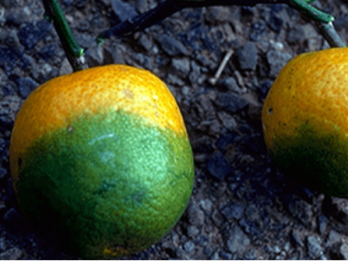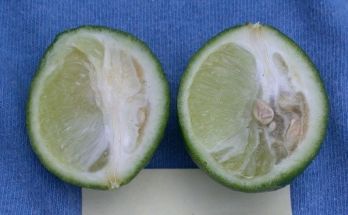Huanglongbing
Huanglongbing (HLB), previously known as citrus greening disease, translates to ‘yellow dragon disease’. It is one of the world’s worst citrus tree diseases.
Background
All commercial citrus is affected by HLB, including Australian natives and ornamentals in the Rutaceae family such as orange jasmine (Murraya).
The disease is caused by the 3 strains of bacteria. Candidatus Liberibacter asiaticus is present throughout Asia, in the Middle East, South America, Central America, the Caribbean, some southern states of the USA, Indonesia, East Timor, and Papua New Guinea. The Torres Straits islands provide a potential pathway for HLB into Australia.
Ca. L. africanus is found in Africa and the Middle East, while Ca. L americanus is in Brazil.
Impacts
The disease targets all plant parts and growth stages of citrus. Infections spread through the tree canopy, causing decline and death of the tree.
Symptoms appear at different rates depending on the:
- strain of bacteria
- species or cultivar
- age and growth stage of the plant
- environmental conditions such as temperature.
HLB is transmitted by movement of infected plants and propagative material. Sap sucking insects such as the Asiatic and African citrus psyllids, can also spread it via feeding on infected plants.
There is currently no cure for HLB. The only way to stop the disease is to destroy all infected trees and replace them.
Management
Management
Growers can put on-farm biosecurity measures in place to reduce the chance of pests and disease getting onto their properties, including:
- using pest-free propagation material and seedlings, sourced from a reputable supplier
- putting up farm biosecurity signs on gates and fences to manage visitors coming onto your property
- avoiding sharing equipment
- keeping equipment and vehicles clean and free of plant matter
- wearing clean clothing before visiting other growers’ properties
- teaching farm workers on-farm hygiene practices, what to look for and how to report unusual pests and diseases
- report suspect symptoms to the Exotic Plant Pest Hotline.
Identification
The first symptom of HLB is a yellow shoot on the tree, which spreads to the entire canopy. The leaves turn pale yellow and show zinc or manganese deficiency, or blotchy mottling with reduced size.
This colouring is the most common indicator but is not specific to HLB. The leaf patterns look similar to stubborn disease (Spiroplasma citri), severe forms of Citrus tristeza virus (CTV), species of Phytophthora, waterlogging, the use of marcots, and early stages of citrus blight. However, HLB does not cause wilting or disrupt the uptake of water and nutrients.
Chronically infected trees are thinly foliated and show extensive twig dieback, with a shortened lifespan. The fruits often:
- are small, lopsided, and poorly coloured
- have a sour or bitter taste
- contain aborted seeds.



